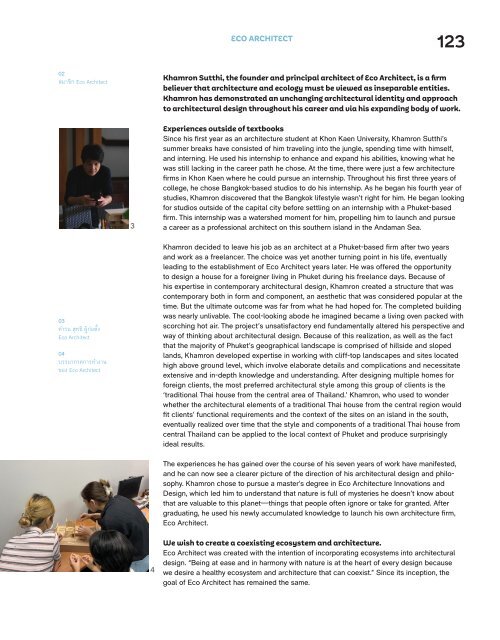ASA Journal 12/2023
You also want an ePaper? Increase the reach of your titles
YUMPU automatically turns print PDFs into web optimized ePapers that Google loves.
ECO ARCHITECT<br />
<strong>12</strong>3<br />
02<br />
สมาชิก Eco Architect<br />
Khamron Sutthi, the founder and principal architect of Eco Architect, is a firm<br />
believer that architecture and ecology must be viewed as inseparable entities.<br />
Khamron has demonstrated an unchanging architectural identity and approach<br />
to architectural design throughout his career and via his expanding body of work.<br />
3<br />
Experiences outside of textbooks<br />
Since his first year as an architecture student at Khon Kaen University, Khamron Sutthi’s<br />
summer breaks have consisted of him traveling into the jungle, spending time with himself,<br />
and interning. He used his internship to enhance and expand his abilities, knowing what he<br />
was still lacking in the career path he chose. At the time, there were just a few architecture<br />
firms in Khon Kaen where he could pursue an internship. Throughout his first three years of<br />
college, he chose Bangkok-based studios to do his internship. As he began his fourth year of<br />
studies, Khamron discovered that the Bangkok lifestyle wasn’t right for him. He began looking<br />
for studios outside of the capital city before settling on an internship with a Phuket-based<br />
firm. This internship was a watershed moment for him, propelling him to launch and pursue<br />
a career as a professional architect on this southern island in the Andaman Sea.<br />
03<br />
คารน สุทธิ ผู้ก่อตั้ง<br />
Eco Architect<br />
04<br />
บรรยากาศการทางาน<br />
ของ Eco Architect<br />
Khamron decided to leave his job as an architect at a Phuket-based firm after two years<br />
and work as a freelancer. The choice was yet another turning point in his life, eventually<br />
leading to the establishment of Eco Architect years later. He was offered the opportunity<br />
to design a house for a foreigner living in Phuket during his freelance days. Because of<br />
his expertise in contemporary architectural design, Khamron created a structure that was<br />
contemporary both in form and component, an aesthetic that was considered popular at the<br />
time. But the ultimate outcome was far from what he had hoped for. The completed building<br />
was nearly unlivable. The cool-looking abode he imagined became a living oven packed with<br />
scorching hot air. The project’s unsatisfactory end fundamentally altered his perspective and<br />
way of thinking about architectural design. Because of this realization, as well as the fact<br />
that the majority of Phuket’s geographical landscape is comprised of hillside and sloped<br />
lands, Khamron developed expertise in working with cliff-top landscapes and sites located<br />
high above ground level, which involve elaborate details and complications and necessitate<br />
extensive and in-depth knowledge and understanding. After designing multiple homes for<br />
foreign clients, the most preferred architectural style among this group of clients is the<br />
‘traditional Thai house from the central area of Thailand.’ Khamron, who used to wonder<br />
whether the architectural elements of a traditional Thai house from the central region would<br />
fit clients’ functional requirements and the context of the sites on an island in the south,<br />
eventually realized over time that the style and components of a traditional Thai house from<br />
central Thailand can be applied to the local context of Phuket and produce surprisingly<br />
ideal results.<br />
The experiences he has gained over the course of his seven years of work have manifested,<br />
and he can now see a clearer picture of the direction of his architectural design and philosophy.<br />
Khamron chose to pursue a master’s degree in Eco Architecture Innovations and<br />
Design, which led him to understand that nature is full of mysteries he doesn’t know about<br />
that are valuable to this planet—things that people often ignore or take for granted. After<br />
graduating, he used his newly accumulated knowledge to launch his own architecture firm,<br />
Eco Architect.<br />
4<br />
We wish to create a coexisting ecosystem and architecture.<br />
Eco Architect was created with the intention of incorporating ecosystems into architectural<br />
design. “Being at ease and in harmony with nature is at the heart of every design because<br />
we desire a healthy ecosystem and architecture that can coexist.” Since its inception, the<br />
goal of Eco Architect has remained the same.

















